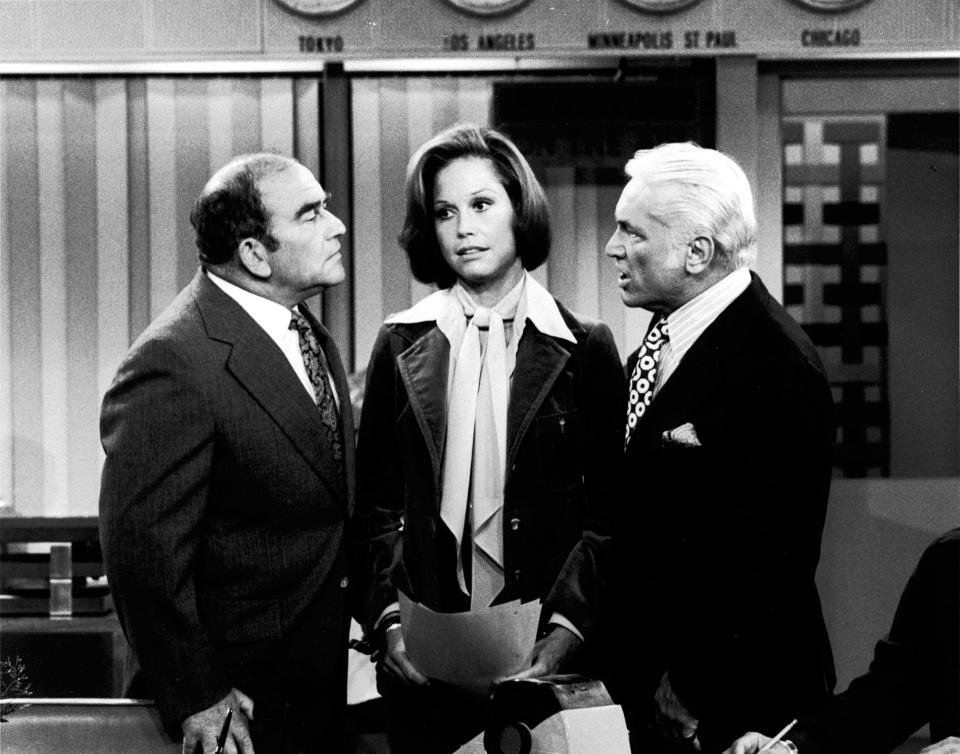'The Mary Tyler Moore Show' turns 50: Love is (still) all around for the trailblazing sitcom
Its development was troubled. Its star was in need of a career turnaround. Its supporting cast was made up of unknowns. And its first episode was dubbed “a disaster” in a Time preview. So fingers were crossed 50 years ago, when "The Mary Tyler Moore Show" premiered on CBS Sept. 19, 1970.
It didn’t take long, though, for those involved to see that love is all around.
“Mary Tyler Moore is a wonderful comedienne with a special gift of reacting to other people,” noted The Hollywood Reporter in its review. “The writing, acting and direction all mesh into a beautiful result. It’s good to have Mary Tyler Moore home again.” (Time eventually agreed.)
A sitcom about a young single Minneapolis newcomer, "MTM" survived its introductory hiccups to become CBS’s crown jewel in the 1970s, running seven years and winning 29 Emmys, then a record haul for a comedy series. It also achieved milestone status as the embodiment of a female-liberation movement that arrived at the same time.
The best of 'Mary': 'The Mary Tyler Moore Show' anniversary: 50 ways we still love the classic sitcom
But for all the plaudits since bestowed on the series and its star, the reality is that zeitgeist is not what got "Mary Tyler Moore" on the air. (Recall that the job opening at WJM-TV that Mary Richards interviews for in the first episode is a secretary.)
Rather, it was CBS’s interest in getting the "Dick Van Dyke Show" co-star back in its lineup four years after that series ended, and on the heels of a top-rated 1969 reunion special. (Moore had spent the preceding years trying, without success, for Broadway and film stardom.)
The network nixed early plans to feature Moore as an era-appropriate divorcee, which would have been a first for a sitcom lead. “It’s hard to believe,” wrote Allan Burns, who co-created the show with James L. Brooks, in a 2017 Hollywood Reporter remembrance, “but in 1970 that was a controversial idea."
Instead, "we came up with the notion that this woman is coming off a long-term relationship with a guy at the Mayo Clinic. ... And that’s what the first show was really about: a woman having to give up her small-town life in Rochester, Minnesota.” Its main title sequence, he says, was used to set up the premise: Moore as Richards, driving off alone to Minneapolis, where viewers are told she might just make it after all. Because love is all around.
The comedy premiered in an inauspicious time slot, sandwiched on Saturdays between another new sitcom, "Arnie," and detective drama "Mannix." It struggled in the ratings at first, but still finished the season as CBS’s most popular new show. Ranking 22nd among all series, it was even more popular than "All in the Family," which premiered a few months later, in January 1971, but didn’t catch on until summer reruns.
When "All in the Family" moved to the Saturday lead-off position the next fall, the night was fortified and propelled "Mary Tyler Moore" into the Top 10. Its own move to 9 the following season became its permanent perch for a five-year reign.

In an era when sitcoms pushed envelopes, "Mary Tyler Moore"'s innovations seem more tied to execution than content. It was built around a single star, but populated by an ensemble of acting equals, whose characters often were the focus of episodes and gave viewers multiple connections to the show. The cast included Valerie Harper and Cloris Leachman as Rhoda Morgenstern and Phyllis Lindstrom, Mary’s apartment-house neighbors, and Ed Asner, Gavin MacLeod and Ted Knight as her work colleagues Lou Grant, Murray Slaughter and Ted Baxter, respectively. (Georgia Engel joined the show in 1972; Betty White in 1973.)
It was also a sitcom that was more com that sit, fueled by character-based storytelling rather than plot devices. That storytelling came to be threaded with weighty issues – from anti-Semitism to infidelity to workplace sexism to journalism ethics – but never in a screaming-headlines way. A 1973 episode even included the casual (and some say first) use of the word gay, in a reference to neighbor Phyllis’s visiting brother.
"Mary Tyler Moore" pivoted on a female point of view. Mary and best friend Rhoda showcased a new image for women in prime-time that connected in real life: single, thirtysomething, alone, working and content. New in 1970, it was deftly reinforced, and the show held up as example as the women’s movement unfolded. Romances came and went for Mary and Rhoda. (Or, as was intimated more than once, came and stayed the night.) But female friendship was forever.
Among the drivers of the woman’s perspective: Susan Silver and Treva Silverman (Silverman’s Outstanding Writing Emmy in 1974 marked the first time a woman won solo in the category; and Joan Darling, director of the morbidly funny 1975 “Chuckles Bites The Dust” episode, rejected by the series’ stable of male directors for being too dark.

Mary Tyler Moore left the air in March 1977 amid fanfare from critics and social observers alike, after seven seasons and 168 episodes, 67 Emmy nominations and those 29 wins. Moore won four Emmys as Lead Actress; the supporting cast picked up a collective 11. It won the Outstanding Writing Emmy five times. And the series itself was named Outstanding Comedy three years in a row, from 1975-77. ("Frasier" later eclipsed its comedy trophy haul.)
Knight died in 1986; Harper and Engel died last year. Moore, long plagued by diabetes, died in 2017 at age 80.
Moore’s Connecticut gravesite features three salutes to the TV show that made her an icon. Its headstone is topped with the words “After All” above a trademark letter M. And a five-foot statue behind it is inscribed “Love Is All Around.”
This article originally appeared on USA TODAY: 'Mary Tyler Moore Show' turns 50: Why the sitcom remains a classic


